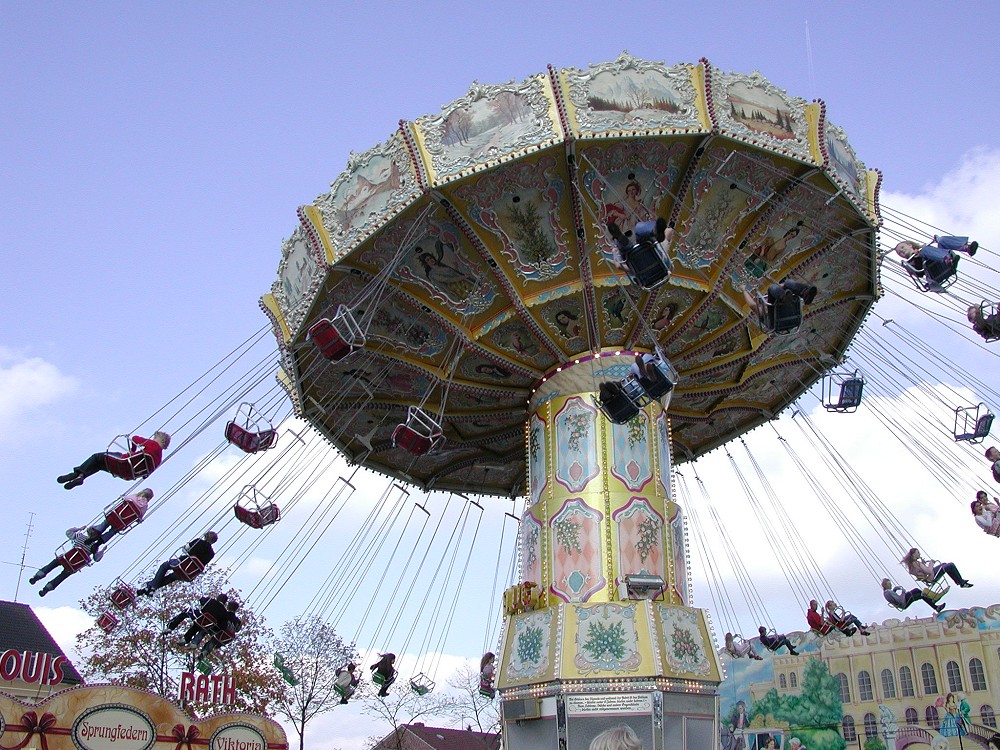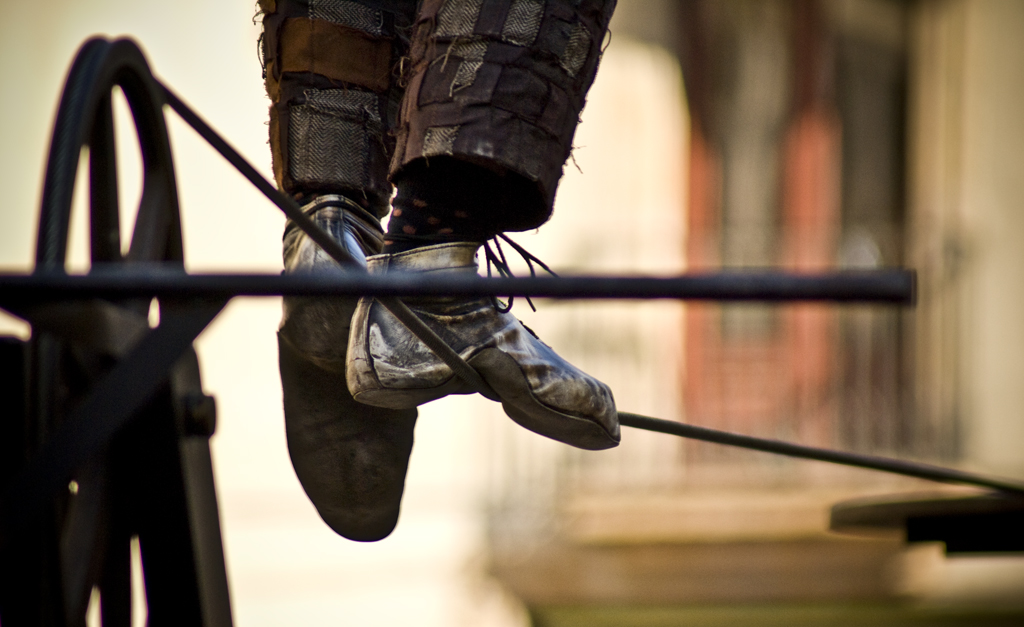|
Philip Astley
Philip Astley (8 January 1742 ŌĆō 20 October 1814) was an English equestrian, circus owner, and inventor, regarded as being the " father of the modern circus". Modern circus, as an integrated entertainment experience that includes music, domesticated animals, acrobats, and clowns, traces its heritage to Astley's Amphitheatre, a riding school that Astley founded in London following the success of trick-riding displays given by him and his wife Patty Jones in 1768. Astley's first competitor was equestrian Charles Hughes, who had previously worked with Astley. Together with Charles Dibdin, a famous author of pantomimes, Hughes opened a rival amphitheatre in London, which Dibdin called the Royal Circus and Equestrian Philharmonic Academy. Astley and his wife Patty put on their first public show on Easter Monday, 4 April 1768. extending the equestrian performance with exhibitions of warlike sabre-work and sword-play. The initial performances were done in the open air at Ha'penn ... [...More Info...] [...Related Items...] OR: [Wikipedia] [Google] [Baidu] |
Circus
A circus is a company of performers who put on diverse entertainment shows that may include clowns, acrobats, trained animals, trapeze acts, musicians, dancers, hoopers, tightrope walkers, jugglers, magicians, ventriloquists, and unicyclists as well as other object manipulation and stunt-oriented artists. The term "circus" also describes the field of performance, training, and community which has followed various formats through its 250-year modern history. Although not the inventor of the medium, Newcastle-under-Lyme born Philip Astley is credited as the father of the modern circus. In 1768, Astley, a skilled equestrian, began performing exhibitions of trick horse riding in an open field called Ha'penny Hatch on the south side of the Thames River, England. In 1770, he hired acrobats, tightrope walkers, jugglers, and a clown to fill in the pauses between the equestrian demonstrations and thus chanced on the format which was later named a "circus". Performances deve ... [...More Info...] [...Related Items...] OR: [Wikipedia] [Google] [Baidu] |
Newcastle-under-Lyme
Newcastle-under-Lyme is a market town and the administrative centre of the Borough of Newcastle-under-Lyme in Staffordshire, England. It is adjacent to the city of Stoke-on-Trent. At the 2021 United Kingdom census, 2021 census, the population was 75,082. Newcastle grew up in the twelfth century around the castle which gave the town its name, and received its first charter in 1173. The town's early industries included Hatmaking, millinery, silk weaving, and coal mining, but despite its proximity to the Staffordshire Potteries, Potteries it did not develop a ceramics trade. Toponym The name "Newcastle" is derived from a mid-12th century motte and bailey that was built after Stephen, King of England, King Stephen granted lands in the area to Ranulf de Gernon, 4th Earl of Chester, Ranulf de Gernon, Earl of Chester; the land was known for his support during the civil war known as The Anarchy. The element ''Lyme'' is found throughout the locality, such as in Lyme Brook and the Fore ... [...More Info...] [...Related Items...] OR: [Wikipedia] [Google] [Baidu] |
Horse
The horse (''Equus ferus caballus'') is a domesticated, one-toed, hoofed mammal. It belongs to the taxonomic family Equidae and is one of two extant subspecies of ''Equus ferus''. The horse has evolved over the past 45 to 55 million years from a small multi-toed creature, '' Eohippus'', into the large, single-toed animal of today. Humans began domesticating horses around 4000 BCE in Central Asia, and their domestication is believed to have been widespread by 3000 BCE. Horses in the subspecies ''caballus'' are domesticated, although some domesticated populations live in the wild as feral horses. These feral populations are not true wild horses, which are horses that have never been domesticated. There is an extensive, specialized vocabulary used to describe equine-related concepts, covering everything from anatomy to life stages, size, colors, markings, breeds, locomotion, and behavior. Horses are adapted to run, allowing them to quickly escape predator ... [...More Info...] [...Related Items...] OR: [Wikipedia] [Google] [Baidu] |
Jane Austen
Jane Austen ( ; 16 December 1775 ŌĆō 18 July 1817) was an English novelist known primarily for #List of works, her six novels, which implicitly interpret, critique, and comment on the English landed gentry at the end of the 18th century. Austen's plots often explore the dependence of women on marriage for the pursuit of favourable social standing and economic security. Her works are implicit critiques of the sentimental novel, novels of sensibility of the second half of the 18th century and are part of the transition to 19th-century literary realism. Her use of social commentary, realism, wit, and irony have earned her acclaim amongst critics and scholars. Austen wrote major novels before the age of 22, but she was not published until she was 35. The anonymously published ''Sense and Sensibility'' (1811), ''Pride and Prejudice'' (1813), ''Mansfield Park'' (1814), and ''Emma (novel), Emma'' (1816) were modest successes, but they brought her little fame in her lifetime. ... [...More Info...] [...Related Items...] OR: [Wikipedia] [Google] [Baidu] |
Charles Dickens
Charles John Huffam Dickens (; 7 February 1812 ŌĆō 9 June 1870) was an English novelist, journalist, short story writer and Social criticism, social critic. He created some of literature's best-known fictional characters, and is regarded by many as the greatest novelist of the Victorian era.. His works enjoyed unprecedented popularity during his lifetime and, by the 20th century, critics and scholars had recognised him as a literary genius. His novels and short stories are widely read today. Born in Portsmouth, Dickens left school at age 12 to work in a boot-blacking factory when his father John Dickens, John was incarcerated in a debtors' prison. After three years, he returned to school before beginning his literary career as a journalist. Dickens edited a weekly journal for 20 years; wrote 15 novels, five novellas, hundreds of short stories and nonfiction articles; lectured and performed Penny reading, readings extensively; was a tireless letter writer; and campaigned vigor ... [...More Info...] [...Related Items...] OR: [Wikipedia] [Google] [Baidu] |
Centrifugal Force
Centrifugal force is a fictitious force in Newtonian mechanics (also called an "inertial" or "pseudo" force) that appears to act on all objects when viewed in a rotating frame of reference. It appears to be directed radially away from the axis of rotation of the frame. The magnitude of the centrifugal force ''F'' on an object of mass ''m'' at the perpendicular distance ''Žü'' from the axis of a rotating frame of reference with angular velocity is F = m\omega^2 \rho. This fictitious force is often applied to rotating devices, such as centrifuges, centrifugal pumps, centrifugal governors, and centrifugal clutches, and in centrifugal railways, planetary orbits and banked curves, when they are analyzed in a nonŌĆōinertial reference frame such as a rotating coordinate system. The term has sometimes also been used for the '' reactive centrifugal force'', a real frame-independent Newtonian force that exists as a reaction to a centripetal force in some scenarios. History F ... [...More Info...] [...Related Items...] OR: [Wikipedia] [Google] [Baidu] |
Tightrope
Tightrope walking, also called funambulism, is the skill of walking along a thin wire or rope. It has a long tradition in various countries and is commonly associated with the circus. Other skills similar to tightrope walking include slack rope walking and slacklining. Types Tightwire is the skill of maintaining balance while walking along a tensioned wire between two points. It can be done either using a balancing tool (umbrella, fan, balance pole, etc.) or "freehand", using only one's body to maintain balance. Typically, tightwire performances either include dance or object manipulation. Object manipulation acts include a variety of props in their acts, such as clubs, rings, hats, or canes. Tightwire performers have even used wheelbarrows with passengers, ladders, and animals in their act. The technique to maintain balance is to keep the performer's centre of mass above their support pointŌĆöusually their feet. Highwire is a form of tightwire walking but performed at much ... [...More Info...] [...Related Items...] OR: [Wikipedia] [Google] [Baidu] |
Juggling
Juggling is a physical skill, performed by a juggler, involving the manipulation of objects for recreation, entertainment, art or sport. The most recognizable form of juggling is toss juggling. Juggling can be the manipulation of one object or many objects at the same time, most often using one or two hands but other body parts as well, like feet or head. Jugglers often refer to the objects they juggle as ''props''. The most common props are balls, clubs, or rings. Some jugglers use more dramatic objects such as knives, fire torches or chainsaws. The term ''juggling'' can also commonly refer to other prop-based manipulation skills, such as diabolo, plate spinning, devil sticks, poi, cigar boxes, contact juggling, hooping, yo-yo, hat manipulation and kick-ups. Etymology The words ''juggling'' and ''juggler'' derive from the Middle English ''jogelen'' ("to entertain by performing tricks"), which in turn is from the Old French '' jangler''. There is also the wi ... [...More Info...] [...Related Items...] OR: [Wikipedia] [Google] [Baidu] |
Westminster Bridge
Westminster Bridge is a road-and-foot-traffic bridge crossing over the River Thames in London, linking Westminster on the west side and Lambeth on the east side. The bridge is painted predominantly green, the same colour as the leather seats in the House of Commons which is on the side of the Palace of Westminster nearest to the bridge, but a natural shade similar to verdigris. This is in contrast to Lambeth Bridge, which is red, the same colour as the seats in the House of Lords and is on the opposite side of the Houses of Parliament. In 2005ŌĆō2007, it underwent a complete refurbishment, including replacing the iron fascias and repainting the whole bridge. It links the Palace of Westminster on the west side of the river with County Hall and the London Eye on the east and was the finishing point during the early years of the London Marathon. The next bridge downstream is the Hungerford Bridge & Golden Jubilee Bridges and upstream is Lambeth Bridge. Westminster Bridge was ... [...More Info...] [...Related Items...] OR: [Wikipedia] [Google] [Baidu] |
Waterloo Road, London
Waterloo Road is the main road in the Waterloo, London, Waterloo district of London, England straddling the London boroughs, boroughs of Lambeth and Southwark. It runs between Westminster Bridge Road close to St George's Circus at the south-east end and Waterloo Bridge across the River Thames towards London's West End of London, West End district at the north-west end. At the northern end near the river are the Queen Elizabeth Hall and the Hayward Gallery to the west, the National Film Theatre below the road, and the Royal National Theatre to the east. In earlier times, this was the location of Cuper's Gardens. Just to the south in the middle of a large roundabout with underground walkways is the British Film Institute (BFI) London IMAX Cinema. Nearby to the east is the James Clerk Maxwell Building of King's College London, named in honour of the physicist James Clerk Maxwell (1831ŌĆō1879), who was a professor at the college from 1860. A little further to the south is St J ... [...More Info...] [...Related Items...] OR: [Wikipedia] [Google] [Baidu] |
Islington
Islington ( ) is an inner-city area of north London, England, within the wider London Borough of Islington. It is a mainly residential district of Inner London, extending from Islington's #Islington High Street, High Street to Highbury Fields and Regent's Canal, encompassing the area around the busy High Street, Upper Street, Essex Road, and Southgate Road to the east. History Etymology The manor of Islington was named by the Saxons ''Giseldone'' (1005), then ''Gislandune'' (1062). The name means "G─½sla's hill" from the Old English personal name ''G─½sla'' and ''dun (fortification), dun'' ("hill", "Downland, down"). The name later mutated to ''Isledon'', which remained in use well into the 17th century when the modern form arose. [...More Info...] [...Related Items...] OR: [Wikipedia] [Google] [Baidu] |








